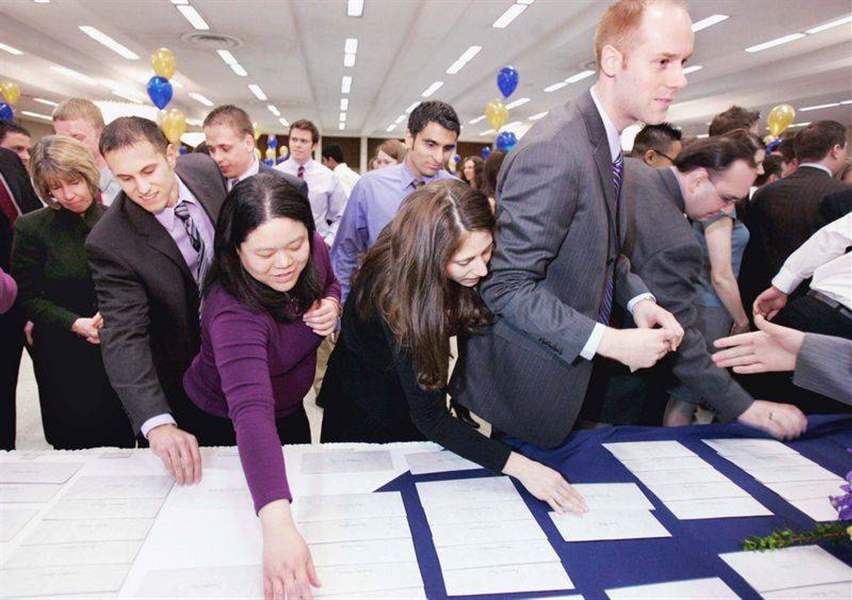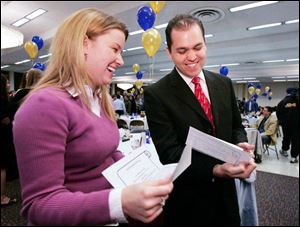
Med students get residency matches
3/16/2007
Students from the University of Toledo medical school, the former Medical College of Ohio, pick up their residency assignments. Only 12 of 151 graduates will stay in northwest Ohio.

Natalie Singer of Cincinnati and David Majors of Walnut, Calif., compare assignment letters for their medical residencies. The two students are among the 151 who will graduate soon from the University of Toledo medical school, the former Medical College of Ohio. All of the students received their residency letters yesterday. Ms. Singer will be at the University Medical Center at UT; Mr. Majors will be in Texas.
It was a day to celebrate for the 151 soon-to-be graduates of the University of Toledo medical school, the former Medical College of Ohio.
But for the city of Toledo, and possibly the quality of health care in northwest Ohio for next decade, the future didn't appear too bright yesterday during the university's letter-opening ceremony for Match Day.
"The envelopes you're about to open are devastatingly bad for northwest Ohio and Toledo," said Dr. Jeffrey Gold, dean of UT's college of medicine.
Match Day is an annual occurrence at medical schools throughout the country when seniors find out to which medical program they have been accepted.
What follows is three to five years of on-the-job training as a hospital resident. Many students become doctors in the communities where they took their residencies.
At yesterday's ceremony inside the Great Hall at the Masonic Complex on Heatherdowns Boulevard, every graduating senior from UT's medical school, formerly known as the Medical College of Ohio, found a matching letter from a residency program waiting for them on a banquet table.
"Absolutely outstanding," Dr. Gold said in his address to students and their families. "This is the largest number we have ever matched."

Students from the University of Toledo medical school, the former Medical College of Ohio, pick up their residency assignments. Only 12 of 151 graduates will stay in northwest Ohio.
Yet Dr. Gold tempered his congratulatory remarks with notes of concern. Just 8 percent of students had matched with a residency program in northwest Ohio, and only 6 percent - nine students - were with a UT program, he said.
Ten years ago, 21 percent of MCO's graduating class of 135 students matched with a program in northwest Ohio.
The process works by students picking their top choice residency programs, and hospitals then selecting their top choices of students.
The National Resident Matching Program, a private nonprofit organization, then uses a computer to align the preferences.
Nationwide this year, 14,201 medical students applied for matches. Of those, 93 percent matched to a residency program and 84 percent matched to one of their top three choices, the organization reported.
Dr. Gold said considering how eight of every 10 doctors in Toledo are alumni of what is now UT medical school or one of its residency programs, the low number of students in this year's class who matched to train in Toledo is unsettling.
"The implications of that for this community are dim," he said.
A panel of visiting physician experts, commissioned by the university and the Toledo Community Foundation, reached a similar conclusion in a December report.
The panel predicted a "crisis" shortage of doctors in Toledo in the next five to seven years because of the medical school's low graduate retention rate for residencies and the region's aging physician workforce.
Retention rates for other Ohio medical universities are about 30 percent, or more than three times that of UT.
A chief problem in Toledo, the report said, is that UT's residency programs have not kept pace with the quality of its medical school programs.
For instance, the university has residency programs in only about a quarter of the 80 or so medical specialty areas, so students with such interests are forced to leave.
Higher quality students can find residency options at programs throughout the country, Dr. Gold said.
Medical student George Markakis, 35, was matched with an ophthalmology program that involves a one-year internship at St. Vincent Mercy Medical Center and three years of residency training through Wayne State University in Detroit.
Mr. Markakis lives in West Toledo with his wife, Maria Markakis, an attorney with Eastman & Smith Ltd. in downtown Toledo , and their 2-year-old son, Aristotle.
Mr. Markakis said he would prefer to stay in Toledo for his full residency, but because there are no residency programs in the area for optometry, he had to look elsewhere.
"If there was a residency here, it would have been one of my top choices," he said. "The closest I could get to Toledo was Detroit."
Mr. Markakis said he is still considering whether he will make the nearly 70-minute commute to Detroit every day or move with his family somewhere between the two cities.
Samantha Gundelman, 25, who matched yesterday with a pediatrics program at New York University, said she will be leaving northwest Ohio for reasons beyond just what's in the hospital.
"I'm a big-city girl," she said.
Contact JC Reindl at:
jreindl@theblade.com
or 419-724-6050.